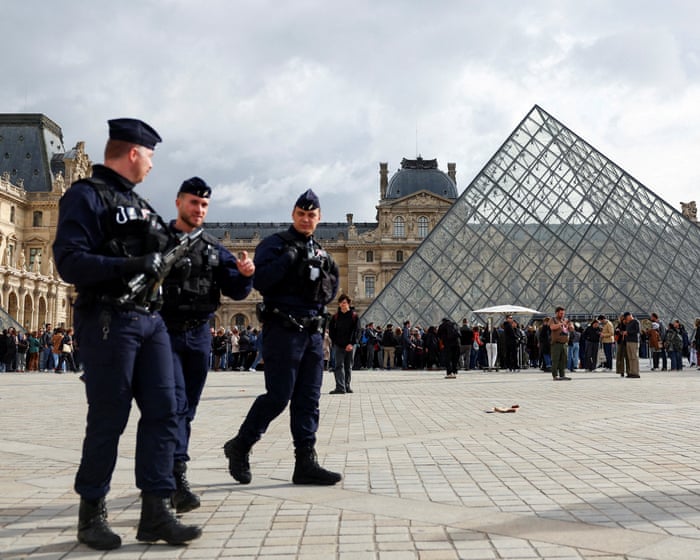The Paris prosecutor has stated that the bold daytime theft at the Louvre was executed by small-time criminals, not professional organized crime figures. Two of the suspects are described as a couple with children.
This announcement comes two weeks after thieves parked a stolen truck outside the world’s most-visited museum, used a furniture lift to access the first floor, and broke into one of its most lavishly decorated rooms. In under seven minutes, they fled on scooters with crown jewels valued at around €88 million (£76 million).
The daring robbery, which took place on a Sunday in broad daylight, has sparked a national reflection in France. Four individuals have been charged, but the stolen treasures—including an emerald and diamond necklace gifted by Napoleon I to his second wife, Marie Louise, and a tiara adorned with 212 pearls and nearly 2,000 diamonds that belonged to Eugénie, wife of Napoleon III—remain missing.
Paris prosecutor Laure Beccuau confirmed on Sunday that at least one other perpetrator is still at large.
French media have suggested the thieves were amateurs after it was revealed they dropped the most valuable item—Empress Eugénie’s crown, crafted from gold, emeralds, and diamonds—during their escape and left behind tools and other items at the scene that could contain DNA evidence.
Beccuau noted that she does not rule out additional accomplices beyond those already charged. She remarked, “This isn’t everyday delinquency… but it’s not the kind typically linked to high-level organized crime,” adding that the accused are locals from Seine-Saint-Denis, one of France’s poorest areas north of Paris.
On Saturday, prosecutors announced that a 38-year-old woman and a 37-year-old man were charged and held in custody after their DNA was allegedly found in the lift used in the theft. The man faces charges of organized theft and criminal conspiracy, while his partner is accused of complicity in the same crimes.
Beccuau described them as a couple with children who have denied any involvement. The woman was reportedly in tears during her court appearance, expressing fear for herself and her children.
Earlier, police arrested two others: a 34-year-old Algerian resident since 2010 and a 39-year-old already under supervision for aggravated theft. These men, charged with theft and criminal conspiracy, have partially admitted their roles, according to Beccuau.
All three male suspects have prior convictions for theft, with two having been convicted together in a theft case a decade ago. Beccuau has not dismissed the possibility of more accomplices.
Three individuals arrested alongside the couple on October 29 were released without charge.
When questioned on Sunday about progress in locating the jewels, Beccuau declined to comment, citing the confidentiality of the investigation.”We are looking into all potential ways this jewelry might be sold on the black market, though I hope that doesn’t occur anytime soon,” she stated. “It might be used for money laundering or illegal trade; we are following every possible lead.”
Frequently Asked Questions
Of course Here is a list of FAQs about the Paris prosecutors statement on the Louvre jewel theft designed with clear questions and direct answers
Basic Information The Event
1 What happened at the Louvre
A theft occurred where valuable jewels were stolen from a display case within the Louvre museum in Paris
2 What did the Paris prosecutor say about the thieves
The prosecutor stated that the theft was carried out by amateur thieves not by organized professional criminals
3 Whats the difference between an amateur and a professional thief in this context
Amateur Likely means they were less skilled may have acted on opportunity used simpler methods and lacked the sophisticated planning and connections of a criminal network
Professional Would imply a highly skilled wellorganized group with a detailed plan specialized tools and a prearranged method to sell the stolen goods on the black market
4 How much were the stolen jewels worth
While official values can vary reports estimated the value of the stolen jewels to be in the hundreds of thousands of euros
Motivations and Methods
5 Why does it matter if they were amateurs or professionals
It significantly changes the investigation Police would look for different suspects methods and motives Amateurs might be easier to catch if they make simple mistakes but they might also have no known criminal profile
6 How could amateurs possibly steal from a highsecurity museum like the Louvre
The prosecutors statement suggests they exploited a security vulnerability such as an unalarmed case or a distracted guard rather than using advanced technology to bypass a complex security system It highlights a potential security failure
7 What was the thieves motive if they werent professionals
Amateurs might have been motivated by a thrill a specific desire for those particular jewels or the belief they could quickly sell them for a large sum without considering the immense difficulty of selling famous traceable items
Investigation and Implications
8 Does this make the jewels easier or harder to recover
It can be a doubleedged sword Amateurs might try to sell the jewels recklessly leading to their capture However without a known criminal network to track the trail can also go cold more quickly
9 What are the common mistakes amateur thieves make
They often leave behind forensic




